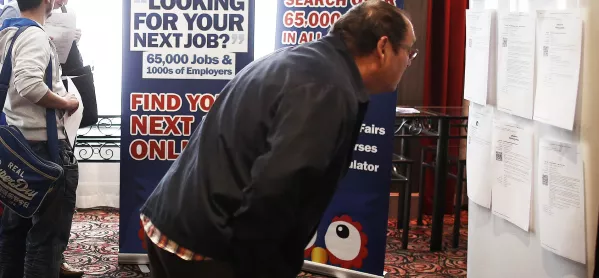Teacher vacancies rise by almost two-thirds in September

There has been a large increase in the number of teacher and leader vacancies at secondary compared with pre-pandemic levels, according to fresh vacancy data.
New TeachVac data due to be published today and seen by Tes reveals a jump of almost two-thirds in jobs being advertised this month compared with the start of term last year.
The news comes after Tes revealed last month that schools were being forced to continue recruitment later into the summer than usual, with school leaders posting “unprecedented” numbers of job advertisements.
This followed a year of high levels of vacancies across the board.
- Exclusive: Teacher vacancy levels ‘unprecedented’ this late on in the year
- Teacher recruitment: Why ‘nothing is going to save us’
- Recruitment and retention: What’s going wrong?
Geoff Barton, general secretary of the Association of School and College Leaders, said the worrying analysis of vacancy numbers reflects feedback the union has received from members and the difficulties that schools are facing in recruiting and retaining staff.
“Teachers and leaders are being asked by the government to do more for less, and that is clearly an unsustainable situation. The government must work with the education sector to address this situation as a matter of urgency.”
In April, TeachVac data seen by Tes revealed that secondary school classroom teacher vacancies were at their highest level in at least five years.
Now, analysis of new TeachVac data reveals an increase in the number of secondary vacancies at the start of the new school year.
The number of vacancies covering headteacher, teacher, deputy headteacher, promoted and assistant headteacher posts recorded between 1 and 13 September 2022 was 1,483 - a 62 per cent increase from the 918 recorded over the same time period in 2019.
Professor John Howson, chair of TeachVac, said he had noticed “the recent record level of teacher vacancies has continued into September”.
“When set alongside the shortfall of recruitment into teacher training, there must be a real concern about the ability of schools to find teachers,” he said.
Schools in and around London were experiencing “the most challenges at all levels,” he added, saying that “staffing our schools must be the number one priority for the new secretary of state”.
Strain on finances is ‘unsustainable’
Andy Byers, headteacher at Framwellgate School in Durham, told Tes that it is “not just the cost” but the “constant recruitment” that is causing problems for schools.
He said this causes a “lack of continuity for the classes - they’re not able to do the planning that most of our new teachers would do because they’re not in place or they’re starting mid-year”.
Vic Goddard, co-principal at Passmores Academy, said that the school recruitment situation is “hopeless”.
He said that the issue was most pronounced with recruiting for Ebacc subjects such as MFL and science.
Mr Goddard has started this academic year with a science teacher vacancy and said there have been no applicants.
He said their success rate for adverts for EBacc subject teachers was around 24 per cent and they “would expect to advertise at least four times before getting one direct application”.
Mr Goddard explained that the situation has been getting worse each year. “We’re in a perfect storm with no end in sight,” he said.
Analysis of TeachVac data also reveals a larger spike in vacancies in regions such as the North East, the West Midlands, London and the South East.
The North East saw a 92 per cent increase on 2019 this year, while the West Midlands saw an 84 per cent increase and London a 68 per cent increase compared with pre-pandemic levels.
Analysis of TeachVac data also reveals a slower growth of demand at primary level.
While the autumn term in 2022 has so far seen an increase in the number of vacancies in the primary sector compared with 2019, this growth has been much slower than in secondary - a 32 per cent increase compared with 62 per cent in the secondary sector.
Professor Howson said that the decline in primary roles is affecting the number of vacancies listed.
Last June, data for primary applications from the Department for Education showed there had been a 5.1 per cent decrease in numbers, with 580,771 new pupils in 2021 compared with 612,146 in 2020.
You need a Tes subscription to read this article
Subscribe now to read this article and get other subscriber-only content:
- Unlimited access to all Tes magazine content
- Exclusive subscriber-only stories
- Award-winning email newsletters
Already a subscriber? Log in
You need a subscription to read this article
Subscribe now to read this article and get other subscriber-only content, including:
- Unlimited access to all Tes magazine content
- Exclusive subscriber-only stories
- Award-winning email newsletters
topics in this article



